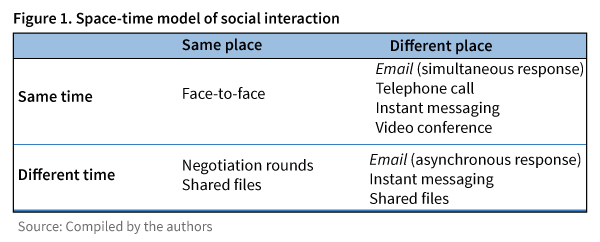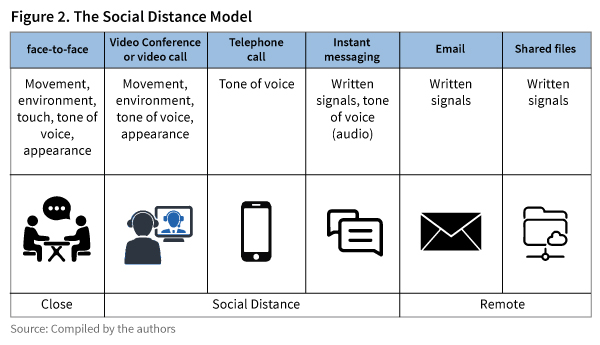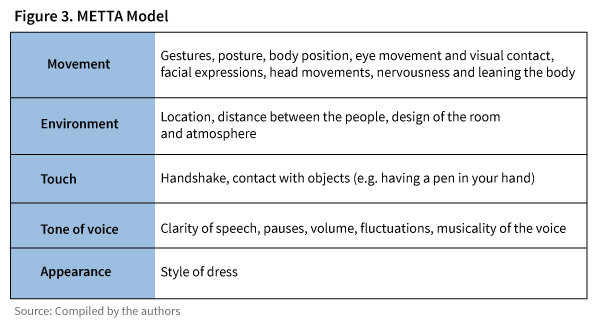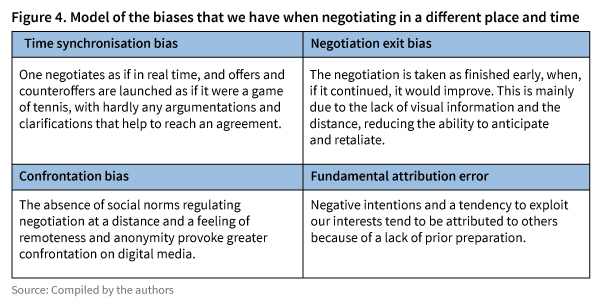By Guido Stein and Kandarp Mehta
When negotiations take place between business organisations, it’s clear that those involved in the discussions will be intensely focused on the content of their exchanges. What is, perhaps, not so evident is the role and influence of the precise media of communication that may be employed in this digital age. As this enlightening article explains, we would be well advised to choose our weapons carefully in the duel of modern business negotiation.
1. New environment
The procurement manager of a pharmaceutical company, a young MBA who has only held their position for a year, is called on by the Director of Research and Development to source a new material within a week. The company has its existing suppliers, and the price negotiations nearly always follow a very predictable course. However, this time, the situation is different. The pressure to find a supplier is high and the only option is one located in another country. The negotiation is conducted via email and the price demanded by the supplier is very high. The procurement manager sticks to the normal policy and asks for a discount, but receives subsequent counter-offers to no avail. The limited time available means this is the only supplier that can serve the company’s needs. Fortunately, an interesting opportunity arises: the following week there is a convention attended by both the Director of Research and Development and this particular supplier. At the end of the event, the director, after face-to-face negotiation, returns after coming to an agreement, in under twenty-four hours, at the preferred price and with a long-term contract. After the successful conclusion of the negotiation, the procurement manager asks what went wrong with the negotiation by email so that it failed to reach an agreement to the satisfaction of both parties.
Negotiations can be very different in nature; for example, face-to-face, in a team, multilateral, incorporating significant multicultural elements, and also those in which the new communication technologies play an important part. In companies and other organisations, negotiations are increasingly conducted online1. In this technical note, we analyse the types of online communication within the context of that pairing that permeates our lives: space and time. We discuss what effects the use of technological tools have on negotiators and what principal biases prevail when using them, as well as the strategies that should be employed in online negotiation processes so as to achieve greater success.
2. How do space and time influence negotiations?
The classic negotiation process takes place in a single venue and in a simultaneous manner, with communication between the parties playing an essential role, amplified by the opportunity to interpret the non-verbal signals, such as, for example, body language. With the latest technological tools, which are driving an unstoppable wave of digitalisation, these two dimensions have been transformed, and even overlap on a single plane. See Figure 1 for a summary chart.

The information transmission and communication process is not just verbal; it also includes the abovementioned body language, which always transmits signals which can be deciphered in a competitive or a collaborative way. Successful negotiators are crack communicators that adapt to the tools at their disposal and to the environment in which they find themselves.
Online communication mechanisms can be organised according to the level of expressivity that the language reaches in them, which depends on the capacity of the medium to communicate with a greater or lesser degree of detail, based on the signals that it includes. Face-to-face negotiation is the transmission method with the highest level of signals (since it includes both verbal and non-verbal communication), while emails are more limited in this regard. On the temporal plane, a second dimension is in the interactivity of the medium, which captures the level of synchronicity of the interactions or the extent to which the individuals work on the same activity at the same time. In face-to-face negotiation, phone calls, video conferences and chats, the interaction is synchronised, since the communication between the two parties is synchronous. Conversely, in negotiation via email, the communication is asynchronous, since you can reply later or whenever you find it convenient.
Bearing in mind the binomial of the space and time dimensions in which the communication between the parties takes place, four situations are identified:
Same time, same place: traditional negotiation takes place in a shared space and in a simultaneous manner. The parties involved rely on direct and immediate communication and a wide variety of signals that offer the possibility of interpreting information quickly, identifying interests and addressing the offers put forward. The uncertainty involved in all negotiations can be better managed than in other settings, as the designated strategy can be implemented with greater efficiency, taking the reactions of both parties into account. Another essential element, which has a greater chance of developing, is the basic level of trust necessary for a negotiation to progress, which frequently depends more on nuance than on data alone. Lastly, interpretations may be more accurate, so the chances of a misunderstanding, which can introduce so much noise into a relationship, are reduced.
Same time, different place: the negotiation process is synchronised, but the parties involved are in different places. Calls or video conferences allow the creation of a feeling of proximity with the other party, though freshness and richness are lost compared to the preceding situation. However, if the parties already know each other and the process is on track, it allows for faster progress. Nevertheless, it is not the best way to start, nor is it advisable for closing a negotiation, particularly if there is a degree of distrust and uncertainty that physical presence would help to manage better. Nevertheless, the use of these channels is increasing and the styles are becoming more adaptable.
Different time, same place: the negotiators interact in an asynchronous manner, though they have access to the same document or share the same physical space at consecutive times. An example could be the tendering of a public project that requires the participation of several companies, presenting their proposals in successive rounds, till the project is awarded to one of them. Another case is that of two or more collaborators working on the same electronic document, negotiating and agreeing on their contributions depending on the successive versions. It is an appropriate environment for contributing to the shared understanding phase of what is being negotiated, the production of packages, the consideration of equivalent offers simultaneously and the final drafting of the agreement, providing that special care is taken and there is recourse to a physical meeting if required by the degree of uncertainty or confrontation.
Different time, different place: response time to emails is becoming ever more rapid, and email is becoming a more synchronous tool. The proliferation of the smartphone has made it the most commonly used device for accessing the internet, currently used by 94.6% of Europeans. Already, in 2016, more than 49% of all emails worldwide were read on mobile devices and tablets (IBM Marketing Cloud, 2016)2. The asynchronous nature of the medium can be turned into an advantage when it comes to negotiating, if it is used with logical and deductive rigour to construct proposals, identify back-up points, elaborate reference-based arguments and present the facts and data that support them. Time and the sequencing level of the information exchanged allow us to understand the messages of the other party more accurately.
3. The Social Distance Model
A third dimension that it is necessary to bear in mind when choosing the medium is social distance. As mentioned, if the distance is minimal or close, such as in a face-to-face negotiation, the language used will be more expressive. Conversely, if the distance is great, such as it is with shared files, the degree of communication will be much lower. Figure 2 shows the ascending model of this distance.

In one typical case of multilateral negotiation, numerous calls had to be made during the preparation phase, and communications by email and chat had to be made use of so as to obtain more information on the interests of the counterparts. Once they sat down to negotiate, they conducted the process face-to-face, but, during one phase of the negotiation, they kept in contact with a department located in another city by video conference. When the time came to close the deal, they created a shared document reflecting all the points reached, editing successive versions that had to be revised until a final proposal acceptable to all was reached. It can certainly be said that the chosen means of communication and interaction influence the quality of the process and also, therefore, its result. The success of the negotiations is ever more closely linked to the technology, and therefore, to the impact of digitalisation it produces.
4. The Online Negotiation Process
On average, an executive receives more than one hundred and fifty emails a day3, covering everything from the most trivial to the most important issues. This constant updating in the face of a major data flow makes many feel that their emails are not read carefully and they initially attribute less trust to the counterpart. Trust, therefore, in comparison with face-to-face negotiations, is lower both in the preparation phase of the negotiation and in the post-negotiation period, which means that long-term relations are less probable (Ebner, 2013). These lower expectations of collaboration are mainly due to the lack of non-verbal communication signals, characterised, according to the METTA model, by movement, environment, touch, tone of voice and appearance (Thompson, 2015), which naturalise the relationship in the negotiation (see Figure 3).

In communication by email, with shared files, the contextual signals disappear. In calls, the only category from this model is tone of voice, though in the video call option, movement, environment and appearance are relatively visible. With instant messaging, the written communication does not retain any of the signals, but a few added functions, such as inserting an audio clip, a video or an image, allow us to increase the non-verbal communication in a selective and, in certain cases, manipulative manner, since only the part that we want to show is seen. In a video conference, all the signals except touch are retained, though they are significantly different from those of face-to-face negotiations, depending on the quality of the software and the medium used.
The greater the social distance, the less the reach of the communication and the greater the complexity in building a fluid relationship based on mutual trust. In the same way, the shorter the social distance from the counterpart with whom we are negotiating, the more easily information can flow with all its subtleties, increasing the probability of generating personal trust, an irreplaceable element in any type of negotiation. Below, the different phases of a negotiating process are reviewed in the light of the impact of digitalisation and online tools in their broadest sense.
4.1. Approach
During the information exchange phase, when efforts are made to understand the interests driving the other party and to reduce uncertainty, more and more negotiators are tending to make telephone calls, have video conferences or use email or WhatsApp for shorter information exchanges, with the aim of streamlining the process. However, with an email, the information is distributed in an asynchronous manner, providing more time for its analysis.
Those who write the message or make the calls have a greater or lesser degree of power and maintain a more or less balanced relationship, depending on the type of negotiation in which they are involved. Some studies on group dynamics in face-to-face negotiations have shown that, between two groups of negotiators, it was only a few who conducted 75% of the process. For example, in a group made up of four people, it was two of them who conducted 62% of the conversation; in a group of six, three conducted more than 70%; and in a group of eight, three conducted more than 70%. Even when the success of the negotiation depended on the contributions, participation was not equal (Thompson and Nadler, 2002).
In communication by email, however, by using technological media to communicate, the party that in principle has more power reduces its capacity to express itself in a non-verbal manner as a leader. There is no direct visual contact, and the impact that relaxed and natural body language can have on an audience is lost.
On the other hand, the virtual and digitalised relationship, with appropriate preparation, offers negotiators representing what is, in principle, a weaker position the chance to participate, since they can tilt the power, express themselves appropriately and write in a clear and concise manner with brief, striking messages. The physical distance balances out the analytical and the persuasive.
If one expresses oneself in an abrupt manner or is perceived to have done so, it tends to provoke a much greater negative impact in the other party (Brett et al., 2007), so opportunities to display warmth and the potential for collaboration in the negotiation are reduced, without necessarily increasing competitive tension, since there are fewer signals that are interpreted in a negative manner.
Depending on the strategy that they want to use, the negotiator must choose the most suitable communication media and the one which, in turn, best suits the phase of the process. If the aim is to show greater cordiality and seek the trust of the counterpart, it is advisable to prioritise face-to-face or video conference negotiation, where social distance is minimum. If, on the other hand, a competitive negotiation is proposed, by using email, negotiators tend to apply eminently logical reasoning in the presentation of the facts, rather than arguments based on appeals to emotions; in this way attention is focused on the message, there is a better management of the responses and a greater tendency to make ambitious offers is recorded. When there is no personal contact, there is a certain degree of anonymity, and differences in power and status are reduced.
4.2. Beginning the Process: Contact
In any negotiation, it is important to make the most of the opportunities offered by the different communication channels. If, for example, email is going to be used repeatedly, it may be useful beforehand to have a first meeting face-to-face or by video conference.
If a call is made, it is important to identify when the negotiation should properly begin, for which reason it is essential to know where the other party is going to be at the time of the call. If we do not ask for or obtain prior information, we do not know where they may be, which works against us.
4.3. Exploratory Phase
In this phase, questions are asked so as to obtain the relevant information that is missing, or for comparison with what is available. The objective is to reduce uncertainty and lay the foundations for the personal relationship upon which the rest of the negotiation edifice will largely be constructed. In the case of email, this phase is usually omitted and it is common to start with the launch of the opening offers directly, introducing levels of risk that are difficult to control. Thus, it is advisable not to reject the opportunity to examine the interests of the counterpart. The advantage of the spatio-temporal distance is that it facilitates the comparison of the information and the reviewing of the calculations and weightings. It also relaxes the conflicts, since it brings with it the “down times” that have to carefully managed in face-to-face negotiations, so that they do not cause strange or unwanted effects, such as mistrust or a misreading with respect to the flow of power (“If they ask for down time, it is because we are cornering them, or they are unsure, or …”).
4.4. Options and Concessions
During this phase, when the counterpart is not visible and there are no social norms regulating the conversation, some aspects of common courtesy are perhaps disregarded and responses given in a blunt manner, so special attention must be given to how the message is interpreted. It must be emphasised that the medium bears almost as much weight as the content.
Another aspect that must be considered is the degree of privacy required during the negotiation. When one writes in a document, for example, one does not know who is receiving the message, or to whom it may immediately be forwarded, or whether the message could be subsequently used for future negotiations, or even if there is a possibility that it might be published. All these considerations seem self-evident, but they are not always sufficiently noticed.
Furthermore, if, in any negotiation, the element of “saving the face of the other party” (how the other ends up personally) has an influence, it is more easily forgotten in a situation where you do not see their face.
4.5. Closing
Once the closing of the negotiation is reached, the satisfaction with the result and the performance is lower among online negotiators (Thompson and Nadler, 2002), with experience indicating that the quality of the result and the possibilities of maximising the benefits tend to be less than in a face-to-face negotiation.
In addition, the potential for a long-term relationship is reduced, since the use of email or the telephone strengthens individual positioning, which promotes a more competitive nature. The shadow of the future, which facilitates the relaxation of the most competitive approaches and encourages inclusive exchanges, is diluted by the virtualisation of the relationship. It is not difficult to counteract this factor; it would be enough to celebrate the closure of the agreement physically or for one of the parties to visit the other.
Since the use of electronic devices, such as tablet or smartphone, eliminates non-verbal communication signals and reduces trust between the parties during the process, this will be even more accentuated at the end, which is generally in itself an eminently competitive phase. So, we must increase the levels of self-control of the parties, at the same time as agreeing ways of reducing the competitive tension when the time comes.
5. Strategies for Successful Online Negotiation
Below, we will examine some guidelines for action that favour a more collaborative approach and the creation of mutual trust.
5.1. Preparation
This is the phase for identifying expectations, analysing interests, assessing power, collating and ordering information and assessing the type of relationship, depending on whether one is faced with a competitive or potentially collaborative context. Using email or the telephone emphasises the importance of knowing who is on the other end, what they need, what they want, what their ambitions are (starting with the personal) and what alternatives are open to them.
It would be advisable to consider an initial approach, striking up a conversation without the explicit purpose of negotiating. As a result of this, information can be shared and obtained, while, at the same time, the perception of distance is reduced. A virtual relationship has to be created.
In an experiment conducted into negotiation by email, half the students who participated had the opportunity to make a five-minute call beforehand, with the limitation of not being able to discuss the issues to be negotiated. The students that made the call behaved in a more collaborative manner and reached better agreements than those that had not had the option of doing so (Thompson y Nadler, 2002).
If it is not possible to make this initial contact, it can be substituted with a video conference or a particularly friendly call, permitting the establishment of more informal contact. One of the possible ways to engender trust is to talk about something you have in common; a quick internet search should suffice to find topics of conversation. Another way of engendering trust is to display a profile photo in the email; it has been shown that replies to email requests to take part in a survey increase when a photograph of the sender is included, making the person more identifiable (Gueguen, Legoherel and Jacob, 2003).
Before initiating the contact, a great help in fostering a good relationship is to enquire about the most suitable time to call or make a video call; there are situations that can cause distractions to the other party or force them to interrupt the call. Politeness always helps to create a pleasant atmosphere, even in virtual relationships. So, it is a good idea to encourage good digitalised manners.
5.2. Contact
Once the two parties have been introduced, they start to establish the negotiation bases. In the event that a strategy has a clearly competitive orientation, the emphasis should be placed on examining the requirements and actual power of the other party, while trying not to show one’s own requirements. However, if the strategy has collaborative potential, the first interactions can be an opportunity to persuade the other party of the common interests. If the interaction is conducted over the telephone, it is necessary to listen actively to the other party, even remaining silent so as to allow them to reveal new information; given the awkwardness of remaining silent, the other party will be more ready to talk. In writing, on the other hand, the negotiator must rely on formality and good manners.
If you have prepared well for the negotiation, making the first call can place one party in an advantageous position if the other has not had time to prepare the process in the desired manner. If, on the other hand, the other party calls first and you do not feel prepared, you shouldn’t hesitate to tell them that you are busy at that moment. However, you shouldn’t wait long before returning the call, once you have prepared yourself.
In video conferences, it is a good idea to maintain visual contact with your counterpart, looking at the camera and trying to avoid missing visual elements of non-verbal communication. Another possibility is to configure the screen so as to have both features. As for the surroundings, the most appropriate is a room equipped for meetings or video calls and free from elements that could distract attention. On a personal level, one should dress in keeping with the situation. One should pay special attention to not misinterpreting the pauses of the counterpart and talking over them. One should also bear in mind that free and low-cost video conference tools often have problems with the audio, reducing the resolution and quality of the call.
5.3. Approach
In this phase, the creation of value continues for the parties involved in the negotiation. If a competitive strategy is adopted, value is demanded at the expense of the other party. If, on the other hand, a collaborative strategy is proposed, value is created together, which will subsequently be distributed. Steps should be taken to avoid attribution bias whereby negative intentions are identified in the counterpart.
In a collaborative negotiation, increasing the exchange of emails will help to collate the information, helping to satisfy common interests. This measure allows the sending of well-reasoned information that can be processed carefully by the other party. Time is fundamental in this case, so as to understand the interests and the options of the other party. Strategies that are usually effective include being sparing with the information, being brief and concise, using language that displays an interest and an intention to collaborate with the other party, defending the proposals and motives, and, in a multilateral negotiation in which one of the parties is dominating the conversation, inviting other parties or potential allies to participate to a greater extent.
Remember not to fall into time synchronisation bias, which involves negotiating as if in real time, making offers and counteroffers, with hardly any of the argumentations and clarifications that help to reach an agreement.
During the online interaction, there are instances where it may be advisable to imitate the other party. In a study conducted in two different geographical areas, a group of negotiators imitated their opponent during an email negotiation: “When the other person uses emoticons in their message, such as ;), the other party should also do so. If they use a certain vocabulary, metaphors, grammar, specific words or abbreviations, such as “y’know” (you know), you should do the same. Both in the experiment conducted in Thailand and in the one conducted in the United States, the imitators that applied online mimicry during the first ten minutes reached more profitable agreements in their negotiations than those that applied them in the last ten minutes of negotiation” (Swaab, Maddux and Sinaceur, 2011). However, sending emoticons and abbreviated language seems a little unprofessional in certain negotiations, and it depends on the cultural context in which the negotiation is taking place.
One must pay special attention not to fall into the snowballing effect. This consists of sending large quantities of information in justification of one of the underlying interests, since the other party may succumb to the temptation of not reading it particularly carefully and responding with the same quantity of information, which could cause a block. A study into this issue states that 70% of emails received by executives receive less than a minute’s attention (Thomas et al., 2006). Additionally, the recipient may interpret it as an “aggression”, such that the emails build up and it becomes impossible to reply to them appropriately. So, it is a good idea to set out a clear argument that can be followed when read quickly, always respecting the message chain as it happens.
The appropriate course of action is to reply to the messages received during the process within a maximum period of twenty-four hours, so as to avoid showing a lack of interest, unless this is precisely the intention. Numerous studies have demonstrated that emails have the highest probability of being opened during the first hour of the day; subsequently, the opening ratio reduces by 5% and, after twenty-four hours, to 1%4. However, the asynchronous nature of this particular tool can be turned to your advantage by reading the message carefully several times and checking the information. It has also been demonstrated how, in synchronous negotiation simulations, there was a greater competitive tendency than in asynchronous negotiations, principally due to the time available, which allowed the exchange of a greater quantity of information more relevant to the process (Pesendorfer and Koeszigi, 2006).
If they make a call, impatient negotiators can transmit a great quantity of information in a limited period, so that the process progresses more rapidly. In this situation, they make the mistake of assuming a “reactive devaluation”, by transmitting that the information is manipulative and serves only their own interests. However, it is also true that it serves to reduce uncertainty and to understand interests. In this context, brevity and clarity work in your favour.
5.4. Generation of Options
In this phase, in a negotiation by email, if there is no trust between the parties and the uncertainty is high, it is more likely that the bargaining will intensify than in a face-to-face negotiation. In order to reduce this competitive tension and not fall into a confrontation bias, the different offers must be proposed in an ordered manner and in separate paragraphs, using multimedia tools such as charts, tables, presentations and reports that elaborate on the argumentation. Secondly, it is a good idea to present offers in packages, rather than variable by variable, with the aim of obtaining more information on the priorities of the counterpart and clearer responses, while at the same time showing flexibility.
Every email written must have its spelling and grammar checked and be edited before being sent to the recipient. When writing it, you should include a greeting at the beginning and a farewell, or simply the signature footer, at the end, except when it is part of a chain of instant messages. To avoid mistakes in the addressees of the message, whose possible recipients should have been reviewed beforehand, it is a good idea to complete the “To” field after finishing writing the email and adding the attachments. Finally, it is advisable to complete the message subject field in an eye-catching manner, so that the most important details stand out. Instead of “Today’s meeting”, it is better to use “Next Meeting, Monday 11/5 at 12:00 hrs”; rather than “Agenda for the negotiation process”, it is better to use “Agenda for the [name] negotiation process for May: principal and secondary points”.
It is essential to respond in accordance with the urgency of the situation and in no more than one day. A delay in the response generates a certain anxiety and a subsequent negative attribution. In a negotiation of a collaborative nature, if more time is required for a response, simply send a quick email requesting this time and create an alert that says when you will be in a position to respond. However, if the other party takes a long time to respond, two suppositions emerge:
The offer is being studied and considered, in expectation of other movements that may influence the negotiation.
They want to foster an image of power: “If I take longer to respond, it is because I have the power to do so”.
In a chain of sent and received messages, it is important to create an experience of uninterrupted contact that fosters a collaborative relationship, writing, for example, “As discussed earlier…”, or copying a fragment of a previous message and, above all, maintaining a similar response time, so as not to desynchronise the conversation. However, it is better not to send emails over the weekend, since most people are annoyed by having their free time invaded by others. In this sense, waiting is moving forward.
In intercultural negotiations conducted by email, since the other person is not present, it is easy to forget certain markers, such as an accent or features that remind us of their origin and, as a consequence, we may make the mistake of employing certain cultural references specific to our own society. This is a further reason why it is advisable to read the message several times before sending it.
5.5. Creating the Agreement
Once the parties have defined the topics to be addressed and the underlying interests, and they have suggested certain options, the distributive phase begins, in which the aim is to realise the created or integrative value and reach an agreement that satisfies both parties. In this phase, it is advisable to propose a previously prepared concession strategy and construct a specific and precise agreement.
There are two crucial elements to an agreement that it is necessary to bear in mind. Firstly, the feasibility of the agreement, for which it helps to be clear about how the solution we have arrived at will be implemented. Secondly, the agreement must be measurable over time; for example, saying “Let’s meet in a week” is preferable to “See you soon”. Precise closures help to avoid future conflict and confusion.
If you are negotiating by email, it is important to sort out any misunderstanding or request clarifications. It also helps to be brief and concise when it comes to writing and to end by summarising, so as to highlight the main points. Also, it is advisable to use the message subject field in a purposeful manner in the final phases.
Once the message is sent, we accept the vulnerability that it may be read by strangers. Word documents that we send contain hidden saved data, such as comments, names of the people who have worked on the document, modification and revision dates, with the client’s confidential or privileged information. For this reason, Word has the option to delete all hidden data5.
This lack of privacy can be used in an advantageous and lawful manner, by recording interactions or resending messages when any information is not clear, or the offer and interests of the other party are inconsistent with the new messages.
If, on the other hand, this situation arises over the telephone, staying silent is a powerful tactic during the concession phase. When one of the parties proposes a change to their position, if the counterpart does not say anything, they may be induced to make another concession. Furthermore, when the other party seems to have finished responding to one of the questions with respect to their interests and objectives in the negotiation, a prolonged silence may make them share more things and reveal more information.
Likewise, there are a considerable number of non-verbal communication signals that can be picked up during a telephone conversation, such as the rhythm, speed, inflexion and volume of the voice of the speaker.
- Most people find it easier to say “no” on the telephone or by email than face-to-face, thanks to the feeling of distance. In this case, it is a good idea to propose alternative tools that provide a greater impression of closeness.
- Inflexion of the voice demonstrates a higher level of agitation, such that, although the counterpart may reject the offer, it can be evident that their level of satisfaction is greater. To avoid this situation, it is useful to prepare and modulate your voice so as to sound professional at all times and not show yourself to be anxious to reach an agreement.
- An initial pause before rejecting the proposal on the table suggests that the person has entered into the realms of acceptability or must articulate their reasoning for rejecting the proposal.
- A significant pause may indicate that an offer is being seriously considered by somebody that did not hesitate to decline previous offers.
5.6. Closing and Follow-up
The moment that a possible agreement is reached, the closing phase begins. However, it is necessary to maintain confidence and avoid consecutively changing positions that are matched by the counterpart, since this could block the negotiation.
The action of “withdrawing from the negotiating table” is much easier in a negotiation by email or over the telephone, so the agreements that have been reached during the process must be respected at all times.
Once the negotiators believe they have reached a resolution, they should take the time to review all the operational terms of the negotiation so as to avoid misunderstandings. Once confirmed, all points of the agreement reached between the two parties should be confirmed by email. One of the most common biases in this situation is that of negotiation exit, that is, taking the negotiation as finished when there are still points to be agreed.
The application of different strategies to the negotiation will help us to reduce the psychological distance from the counterpart. Depending on the phase and the device used, we can better develop our interests, achieve greater power without it becoming a competitive relationship, improve the relationship and reduce uncertainty, with the aim of obtaining valuable information, helping us to meet our expectations.
Biases are especially delicate during closure. Figure 4 summarises some of the main ones.

6. Final Remarks
Negotiation is a way to solve problems by creating value for the negotiating parties; it is not a zero-sum game. The parties decide to give and receive, to demand and to grant via a process in which they influence, convince and counteract each other, proposing solutions and agreeing how to implement them together. It makes sense to negotiate when, after having done so, the parties come out better off than before the negotiation. This means changing the mentality of demanding more from the other for that of exchanging more, since the counterparts can solve their own problems only to the extent that they resolve those of the others. Managed with expertise and common sense, technology can contribute effectively to this change.
This article was originally published on 19 June 2020.
About the Authors
 Guido Stein is Professor in the Department of Managing People in Organisations and Director of Negotiation Unit. He is partner of Inicia Corporate (M&A and Corporate Finance). Prof. Stein is a consultant to owners and management committees of companies. Member of The International Academy of Management and the International Advisory Board MCC (Budapest) and is a collaborator with People and Strategy Journal, Corporate Ownership & Control , Harvard Deusto Business Review, The European Business Review and Expansion. Prof. Stein’s books in English include “Managing People and Organisations: Peter Drucker’s Legacy”, “Now What? Leadership and Taking Charge” and co-author of “Keys to Leadership Success”. He is now working on a book, “Ambidextrous Negotiator” with Kandarp Mehta.
Guido Stein is Professor in the Department of Managing People in Organisations and Director of Negotiation Unit. He is partner of Inicia Corporate (M&A and Corporate Finance). Prof. Stein is a consultant to owners and management committees of companies. Member of The International Academy of Management and the International Advisory Board MCC (Budapest) and is a collaborator with People and Strategy Journal, Corporate Ownership & Control , Harvard Deusto Business Review, The European Business Review and Expansion. Prof. Stein’s books in English include “Managing People and Organisations: Peter Drucker’s Legacy”, “Now What? Leadership and Taking Charge” and co-author of “Keys to Leadership Success”. He is now working on a book, “Ambidextrous Negotiator” with Kandarp Mehta.
 Kandarp Mehta is a PhD from IESE Business School, Barcelona. He has been with the Entrepreneurship Department at IESE since October 2009. His research has focused on creativity in organisations and negotiations. He frequently works as consultant with startups on issues related to Innovation and Creativity. His doctoral thesis was about the process of creativity in the context of motion picture industry. He has conducted several Negotiation and Creativity Workshops for corporate executives and management students in Europe, USA and India. Before coming to Spain, he was at ICFAI Business School in India where he taught Corporate Finance. He is also actively involved with Creative Industries. He has been actively involved with theatre, as a director, script writer as well as a performer. Several movies and short films where he participated during his PhD dissertation have been exhibited at prestigious film festivals.
Kandarp Mehta is a PhD from IESE Business School, Barcelona. He has been with the Entrepreneurship Department at IESE since October 2009. His research has focused on creativity in organisations and negotiations. He frequently works as consultant with startups on issues related to Innovation and Creativity. His doctoral thesis was about the process of creativity in the context of motion picture industry. He has conducted several Negotiation and Creativity Workshops for corporate executives and management students in Europe, USA and India. Before coming to Spain, he was at ICFAI Business School in India where he taught Corporate Finance. He is also actively involved with Creative Industries. He has been actively involved with theatre, as a director, script writer as well as a performer. Several movies and short films where he participated during his PhD dissertation have been exhibited at prestigious film festivals.
References
• AMES, D. and J. Parlamis (22 May 2010), “Face-to-Face and Email Negotiations: A Comparison of Emotions, Perceptions and Outcomes”. Available at papers.ssrn.com/sol3/papers.cfm?abstract_id=1612871.
• BERNAD, J. (February 2018), “Escribiendo emails”, Manual de escritura eficiente, p. 24.
• BRETT, J. (2007) “Negotiating Globally: How to Negotiate Deals, Resolve Disputes, and Make Decisions Across Cultural Boundaries”. Available at https://zodml.org/sites/default/files/Negotiating_Globally_How_to_Negotiate_Deals%2C_Resolve_Disputes%2C_and_Make_Decisions_Across_Cultural_Boundaries_%28Jossey-Bass_Business_%26_Management%29.pdf
• BÜLOW, A. M. (1 August 2011), “The Double Monologue Principle: Argumentation in Email Negotiation”. Available at papers.ssrn.com/sol3/papers.cfm?abstract_id=1899225.
• BÜLOW, A. M. (13 December 2010), “Email Negotiation: Argument, Cognition and Deadlock in Email Negotiation”. Available at research.cbs.dk/en/publications/email-negotiation-argument-cognition-and-deadlock-in-email-negoti.
• CRAVER, C. B. (7 October 2015), “How to Conduct Effective Telephone and E-Mail Negotiations”. Available at papers.ssrn.com/sol3/papers.cfm?abstract_id=2670011.
• COOPER, C. (2018) “Current Issues in Work and Organizational Psychology”. Available at https://books.google.es/books?id=kT9sDwAAQBAJ&pg=PT104&lpg=PT104&dq=thomas+2006+70%25+email+less+one+minute&source=bl&ots=X1sbaijic1&sig=ACfU3U38lDBrSgtkcaBiXwKTGK4klUb5NQ&hl=en&sa=X&ved= 2ahUKEwjJ69qup9fiAhUU7eAKHdhyD0sQ6AEwAHoECAgQAQ#v = onepage&q = thomas % 202006 % 2070 % 25 % 20email % 20less % 20one % 20minute& f=false
• DITRENDIA (2018), “Todas las estadísticas sobre móviles que deberías conocer #MWC18”. Available at mktefa.ditrendia.es / blog / todas-las-estadísticas-sobre-móviles-que-deberías-conocer-mwc18.
• EBNER, N. (5 September 2017), “Negotiation via Videoconferencing”. Available at papers.ssrn.com / sol3 / papers.cfm?abstract_id=3029020.
• EBNER, N. (2 November 2013), “Negotiation via Email”. Available at papers.ssrn.com /sol3 / papers.cfm?abstract_id=2348111.
• EBNER, N. (9 December 2010), “Trust-Building in E-Negotiation”. Available at papers.ssrn.com /sol3 / papers.cfm?abstract_id=1722065.
• EBNER, N. et al. (24 April 2009), “You’ve Got Agreement: Negoti@ting Via Email”. Available at papers.ssrn.com /sol3 /papers.cfm?abstract_id=1392474.
• FROST, A. (1 April 2019), “The Best Way to Reach Out to a Prospect for the First Time, According to 20 Sales Experts”. Available at blog.hubspot.com /sales / the-best-way-to-reach-out-to-a-prospect-for-the-first-time.
• GUÉGUEN, N., P. Legoherel, C. Jacob, (2003) “Solicitation of participation in an investigation by e-mail: Effects of the social presence of the physical attraction of the petitioner on the response rate”. Available at https://books.google.es/books?id=1pGkEmri1JEC&pg=PA70&lpg=PA70&dq=Gueguen,+Legoherel+y+Jacob,+2003&source=bl&ots=HcuNki5BJJ&sig=ACfU3U3fhvetsJotej1JO40414E7vUhBfQ&hl=es&sa=X&ved=2ahUKEwjoobbyq8HiAhWt3OAKHctHBs0Q6AEwCnoECAcQAQ#v=onepage&q=Gueguen%2C%20Legoherel%20y%20Jacob%2C%202003&f=false
• HAIM, G. et al. (2015), “Learning Human Negotiation Behavior Across Cultures”. Available at www.ise.bgu.ac.il/faculty/kobi/Papers/HaimEtal10.pdf.
• HARROCH, R. (2 March 2017), “15 Tactics for Successful Business Negotiations”. Available at www.forbes.com/sites/allbusiness/2016/09/16/15-tactics-for-successful-business-negotiations/#5778f0f42528.
• IBM, Marketing Cloud (13 January 2016) “2016 Email Marketing Metrics Benchmark Study”. Available at https://www.ibm.com/downloads/cas/PVKXPKNG
• LYNETT, M. (12 October 2016), “The Advantages and Disadvantages of Shared Documents”. Available at blog.mesltd.ca/the – advantages – and – disadvantages – of – shared – documents.
• MCGINN, K. L., and E. Wilson (1 March 2004), “How to Negotiate Successfully Online”. Available at www.hbs.edu/faculty/Pages/item.aspx?num=16493.
• NADLER, J., and D. Shestowsky (1 January 1970), “Negotiation, Information Technology, and the Problem of the Faceless Other”. Available at https://www.scholars.northwestern.edu/en/publications/negotiation-information-technology-and-the-problem-of-the-faceles.
• NAQUIN, C. E., and G. D. Paulson (February 2003), “Online Bargaining and Interpersonal Trust”. Available at www.ncbi.nlm.nih.gov/pubmed/12675399.
• NAST, D. (26 July 2018), “Negotiating for the Future”. Available at www.raconteur.net/business-innovation/negotiating-for-the-future.
• PASCUAL, J. A. (2 April 2018), “Cómo limpiar los datos ocultos de un documento de Word”. Available at computerhoy.com/noticias/software/como -limpiar – datos – ocultos – documento – word – 78409.
• PESENDORFER, E.-M., and S. T. Koeszegi (2006), “Hot versus cool behavioural styles in electronic negotiations: The impact of communication mode”, Group Decision and Negotiation, 15.
• STUHLMACHER, A. F., and M. Citera (September 2005), “Hostile Behavior and Profit in Virtual Negotiation: A Meta-Analysis”. Available at link.springer.com/article/10.1007/s10869-005-6984-y.
• SWAAB, R. I., W. W. Maddux, and M. Sinaceur (2011), “Early Words that Work: When and How Virtual Linguistic Mimicry Facilitates Negotiation Outcomes”. Available at www.sciencedirect.com/science/article/pii/S0022103111000060.
• THOMPSON, L., and J. Nadler (2002), “Negotiating Via Information Technology: Theory and Application”. Available at pdfs.semanticscholar.org/4f5c/0a263a62f051ae5d3b67c365ad5b387b4c37.pdf.
• THOMPSON, J. (2015) “Non-Verbal Communication and the Skills of Effective Mediators: Developing Rapport, Building Trust, and Displaying Professionalism”. Available at https://www120.secure.griffith.edu.au/institutions.do
• WRÓBEL, P. (2017), “The Use of Electronic Communication Tools in the Office Workplace”. Available at www.wzr.ug.edu.pl/.zif/1_10.pdf.
• ZHOU, H. (9 February 2009), “Body Language in Business Negotiation”. Available at www.ccsenet.org/journal/index.php/ijbm/article/view/1680.
References on video
• DIAMOND, S. (15 December 2014), “Getting More | Negotiating Over Email, Phone, etc.”. Available at www.youtube.com/watch?reload=9&v=90u0e5ScFHY.
• EBNER, N. (12 February 2015), “Negotiating via the New Email – Ignacio Mayoral interviewing Noam Ebner”. Available at www.youtube.com/watch?v=ZLpVm6iZfq8.
• SMITH, D. A. (28 February 2013), “10 Steps to Powerful Telephone Negotiations”. Available at www.youtube.com/watch?reload=9&v=U7a0tzL3vmg.
• WEISS, J. (10 January 2019), “The Wired Negotiator | Joshua Weiss | TEDxSpringfield”. Available at www.youtube.com/watch?v=8uC_-SLW6YM.



























![“Does Everyone Hear Me OK?”: How to Lead Virtual Teams Effectively iStock-1438575049 (1) [Converted]](https://www.europeanbusinessreview.com/wp-content/uploads/2024/11/iStock-1438575049-1-Converted-100x70.jpg)




